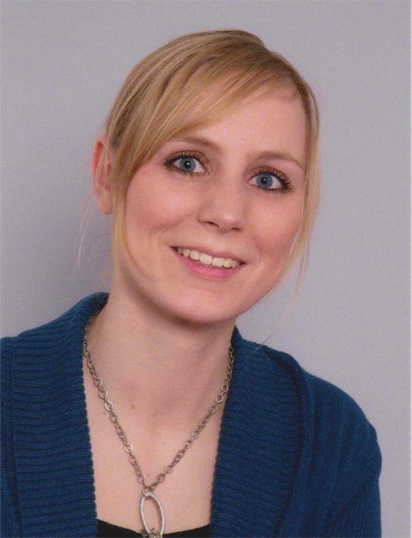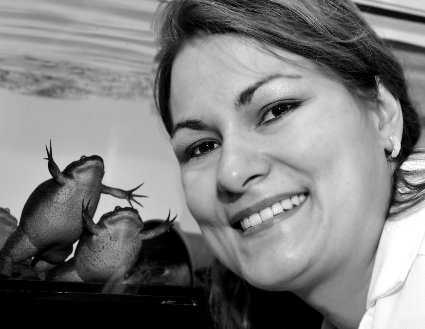Participants in the Joint-PhD-programme
Heidi Ali-Kippari, Faculty of Biochemistry and Molecular Medicine, University of Oulu
in cooperation with Prof. Dr. Pamela Fischer-Posovszky, Clinic of Pediatric and Adolescent Medicine, Ulm University.
PhD project: The role of the Ubiquitin-specific protease 28 (USP28) in adipose tissue homeostasis. Supervised by Prof. Dr. Thomas Kietzmann.
Obesity is an increasing public health issue in developed countries. Adiposity leads to the increased risk of metabolic syndrome and several other pathologies by changing adipose tissue function and signaling. The occurrence of hypoxia in obese adipose tissue is suggested as a reason behind the low grade inflammation leading to the development of the pathologies.
In hypoxia over 500 signaling molecules are upregulated. Among those is the key oxygen-response regulator hypoxia-inducible factor-1α (HIF-1α). Recent data from our group show a new, VHL independent, HIF-1α degradation pathway via the glycogen synthase kinase 3β (GSK-3β). In the absence of insulin HIF-1α is phosphorylated by GSK-3, targeting it to proteasomal degradation by Fbw7-mediated ubiquitination. This degradation can be antagonized by the ubiquitin-specific protease 28 (USP28), indicating that USP28 links hypoxia signaling with insulin-dependent metabolism.
Since insulin is a major regulator of lipid metabolism and adipose tissue homeostasis, it is the aim of this research project to identify the role of USP28 in adipose tissue homeostasis and metabolism. We aim to better understand the role of USP28 in mice and to investigate USP28-dependent target gene networks. In order to achieve this, we will study the accumulation of fat, the transcriptome and USP28 affected gene networks in knockout mice.

Zenglai Tan, Faculty of Biochemistry and Molecular Medicine, University of Oulu
in cooperation with Prof. Dr. Michael Kühl, Medicial Faculty, Institute of Biochemistry and Molecular Biology
PhD-project: Analysis of the fundamental cellular and molecular control mechanisms of the nephrogenesis, supervised by Prof. Dr. Seppo Vainio
On embryonic day (E) E10 of mouse development, mesenchymal cells at the posterior end of the intermediate mesoderm acquire the competence to form the metanephric kidney and differentiate into nephrons. The mechanisms that establish this pool of progenitor cells, the metanephric blastema, and drive some of these cells into the nephron lineage are little understood.
The main methodology of our group is based on the classical in vitro organ culture namely the nephrogenic induction model. Further modification and optimization of this experimental system by high-throughput transcriptomic analysis and 4D (3D plus time) high resolution confocal microscopy allows to study the early steps of nephrogenesis in much more elaborate manner.
Preliminary results of microarray profiling revealed candidate genes (including Osr1, Pax2, Six2, Pod1, Notch2, Pax8, Fgf8 and Wnt-4) responsible or at least involved in regulation of nephrogenic induction. I will take advantage of the method of "dissociation and reaggregation" of metanephric mesenchyme to further analyse the role of these genes by "gain of function" (using viral transduction methods) and "loss of function" (using siRNA knockdown) approaches.
We expect to obtain fundamental information of the genetic program that sets the nephrogenesis competence; to gain a better understanding of the Wnt induced program that builds the nephron.

Sarah Brockmann, Department of Neurology, Ulm University
In cooperation with Petri Kursula, Faculty of Biochemistry and Molecular Medicine, University of Oulu
PhD project: Functional screening for novel ALS candidate genes supervised by Prof. Dr. Jochen Weishaupt
Amyotrophic lateral sclerosis (ALS) is a neurodegenerative disease affecting both upper and lower motor neurons. It is known for its rapidly spreading paralysis that finally leads to patient’s death from respiratory failure after an average of three to five years after diagnosis. So far only about 50% of both familiar and sporadic gene mutations causing ALS are clarified. To improve this number a large approach of exome sequencing of patient material retrieved from the Ulm ALS biobank cohort was carried out. In this regard we and others found a novel ALS candidate gene called coiled-coil-helix-coiled-coil-helix domain containing 10 (CHCHD10). Up to date CHCHD10 is the first “ALS gene” directly associated with mitochondria. Apart from its mitochondrial location only little is known about this protein.
The major aim of my PhD project is to characterize the function of CHCHD10 in healthy persons as well as in ALS patients. Since we hypothesize that CHCHD10 might play a role in the regulation of the cellular respiratory chain our intention is to analyze the mitochondrial function of the mutated protein and compare it to a wild-type control. That will lead to the question of the overall function of mitochondria in ALS. In a biochemical approach we will use HEK293T cells, H4 (Human Neuronal Glioma cell line) and patient lymphoblasts as model systems to analyze interaction partners of CHCHD10. Moreover, zebrafish embryos will be used to study the function of CHCHD10 in vivo.

Ponna Srinivas Kumar, Faculty of Biochemistry and Molecular Medicine, University of Oulu
In cooperation with Prof. Tobias Böckers, Department of Anatomy and Cell Biology, Ulm University
PhD project: Structural biology of postsynaptic density Shank proteins. Supervised by Prof. Petri Kursula, Oulu University
Shank family proteins (Shank1, Shank2 and Shank3) are postsynaptic density (PSD) proteins present in the excitatory neurons. They are multidomain proteins that interact directly or indirectly with PSD membrane receptors, including the NMDA and metabotropic glutamate receptors and the actin-based cytoskeleton. In the brain, Shank proteins are mainly expressed in the cortex and hippocampal neurons. Mutations in Shank are mainly related to many neurobiological disorders, such as autism spectrum disorders (ASD), intellectual disability, schizophrenia, obsessive-compulsive disorder and bipolar disorder. These diseases are classified as ‘synaptopathies’ (dysfunction of synapse), because the genes mutated in these disorders lead to abnormal synaptic development or function. All members of the SHANK gene family, which encode for core scaffolding proteins organizing macromolecular complexes at the PSD, have been linked to human synaptopathies. Therefore, in this PhD, we would like to understand the structural and functional properties of Shank proteins in combination with different molecular approaches, which will give a detailed insight into molecular mechanisms involved in these neurobiological disorders.
Three main lines of research serve as motivation to this project.
1. Understanding the differences of the 3 Shank isoforms at the structure/function level.
2. Analysis of disease-related Shank point mutations.
3. Structural studies on complexes between Shank and its ligand proteins, as well as Shank constructs containing more than one domain.
Throughout the project, the emphasis will be on Shank3, but when relevant, the other isoforms are also considered.

Olga Bibikova, Faculty of Information Technology and Electrical Engineering, University of Oulu
In cooperation with Prof. Dr. Boris Mizaikoff, Institute for Analytical and Bioanalytical Chemistry.
Phd-project: Plasmon-resonant gold nanoparticles as drug carriers and optical labels for cytological investigations, supervised by Dr. Matti Kinnunen
Advances in development of plasmon-resonant nanoparticles (PRNPs) provide wide possibilities to use PRNPs with variable morphology in practically all biophotonic and biomedical applications due to the unique physical and chemical properties, specifically, plasmon resonance depending on particle size, shape, and structure.
The aim of the PhD research is design and synthesis of plasmon-resonant nanostructures for optical diagnostics and therapy of cancer (theranostics) at cell and tissue levels.
Research questions of the doctoral study are improvement of theranostic (composite) nanoparticle properties for simultaneous fluorescence diagnostics and drug delivery; development of gold nanoparticles as agents for optical coherence tomography of heterogeneous structures (blood vessels) and as contrast labels for confocal laser microscopy for real-time visualization of the living cells; design of nanostructures for cells optoporation and transfection.
The PhD project is focusing on the following topics:
1. Nanocomposites, containing drug-loaded mesoporous silica and gold nanostars as a core.
In frames of first research question the main attention is paid to the estimation of the plasmon-resonant nanocomposites, containing drug-loaded mesoporous silica and gold nanostars as a core as anticancer drug carriers and optical labels.
2. Gold nanoparticles as agents for optical coherence tomography and confocal microscopy.
In particular, the goals of current part of research lye on synthesis and characterization of gold nanoparticles with different morphology to assess their plasmon resonance and scattering properties important for applications in biophotonics and diagnostics.
3. Nanostructures consisting of cationic gold nanoparticles and DNA-plasmids.
The third target of the following study is to optimize the method of optoporation (plasmonic resonance – mediated cell permeabilisation) using different physical conditions and different types of gold nanoparticles to achieve the high efficiency of DNA/RNA delivery to dissociated cells of mouse metanephric kidney.

Juliane Sachsenweger, Department of Gynecology and Obstetrics, Ulm University
In cooperation with Prof. Robert Winqvist, Laboratory of Cancer Genetics and Tumor Biology, Department of Clinical Chemistry and Biocenter Oulu
PhD-Project: Molecular mechanisms leading to DNA damage response defects in patient cells carrying heterozygous mutations in the PALB2 or ABRAXAS genes, supervised by Prof. Lisa Wiesmüller
Breast cancer is the most common cancer in women worldwide. Hereditary mutations in multiple genes of the DNA damage response (DDR)/DNA double-strand break (DSB) repair pathways have been found to associate with an increased breast cancer risk. In my studies I focus on mutations in the breast cancer susceptibility genes PALB2 and ABRAXAS.
The c.1592Tdel Finnish PALB2 founder mutation causes an approximately 6-fold increase of the breast cancer risk. Although the function of Palb2 in the regulation of homologous recombination is well understood, the effect of the PALB2 c.1592Tdel mutation on DSB repair has not been sufficiently studied yet. The same holds true for the Finnish ABRAXAS c.1082G>A mutation. The objective of my project is therefore to elucidate the DSB repair activity of cells from patients displaying a hereditary breast cancer predisposition from the Northern Finnish population. In particular my following aims are to be achieved:
1. Assessment of the DSB repair capacity/quality of PALB2 c.1592Tdel and ABRAXAS c.1082G>A cells. Since these mutations represent a risk factor for breast cancer, it is particularly important to understand how they affect the genome integrity.
2. The Comparison of the DSB repair capacity/quality of primary cells and cell lines from heterozygous mutated individuals between Northern Finnish and other population helps to assess the effect of different predisposing mutations and may improve the understanding of the effect of the genetic background.

Verena Zoller, Department of Pediatrics and Adolescent Medicine, Ulm University
in cooperation with Prof. Dr. Kietzmann, Faculty of Biochemistry and Molecular Medicine, University of Oulu
PhD-project: Regulation of adipose tissue homeostasis by the death ligand TRAIL; research Area: Cardiometabolic Disorder, supervised by PD Dr. Pamela Fischer-Posovszky
The excessive accumulation of fat in obesity leads to local hypoxia and inflammation of adipose tissue and subsequently to severe co-morbidities such as cardiovascular disease and type 2 diabetes mellitus. There is accumulating evidence that death receptor signaling might provide the link between adipose tissue hypoxia and subsequent events such development of insulin resistance. TNF-a is overexpressed in obese adipose tissue and involved in the development of insulin resistance (1). Adipocyte-specific deletion of CD95 results in improved glucose homeostasis and decreased systemic inflammation in mice challenged with a high-fat diet (2). Interestingly, obesity is associated with elevated serum concentrations of TRAIL (3).We claim that TRAIL is regulating adipose tissue homeostasis as local levels of TRAIL and TRAIL-R are elevated in adipose tissue in the obese state (4). In preliminary experiments TRAIL stimulated preadipocyte proliferation and inhibited adipogenic differentiation in vitro.
We hypothesize that local hypoxia and subsequent inflammation are causing enhanced TRAIL and TRAIL-R levels and propose that in the obese state TRAIL might prevent expansion of adipose tissue by keeping the pool of precursors in the undifferentiated state.
Our major aims are:
1. to explore the role of hypoxia in the obesity-mediated upregulation of TRAIL and its receptor in adipocytes;
2. to intensively characterize the proliferative and anti-adipogenic effects of TRAIL and identify the underlying molecular mechanisms mediating these effects in vitro and in vivo.
Human SGBS cells and primary preadipocytes are used as model systems. The SGBS cells derive from white adipose tissue of a patient with Simpson-Golabi-Behmel syndrome (SGBS) and are high capacity for adipose differentiation under chemically defined conditions in vitro (5).

Franziska Seigfried, Institute of Biochemistry and Molecular Biology, Ulm University
in cooperation with Prof. Seppo Vainio, Ph.D., Faculty of Biochemistry and Molecular Medicine, University of Oulu
PhD-project: The role of Frizzled 3 and its target genes during Xenopus laevis development
During embryonic development organogenesis is driven by growth factors such as Wnt proteins (Wingless-type MMTV integration site family member). Wnt ligands bind to Fzd (Frizzled) receptors thereby activating different intracellular signaling pathways.
The Fzd3 receptor is known to influence organogenesis via its direct target gene alcam (activated leukocyte cell adhesion molecule). Part of the 5’ untranslated region of alcam, that features two Pax2 (Paired box gene 2) and seven ATF2 (Activating transcription factor 2) binding sites, has been found to trigger the expression of Alcam protein (Cizelsky et al., Development, 2013). The exact mechanism of gene activation however, is not understood so far. My aim is to further characterize the promoter region of alcam in order to elucidate the mechanism of alcam expression.
In addition, I am stydying the role of Alcam during organogenesis in more detail by characterizing the function of identified Alcam interaction partners using antisense strategies in Xenopus laevis.

Susanna Kaisto, Faculty of Biochemistry and Molecular Medicine, University of Oulu
in cooperation with Prof. Dr. Michael Kühl, Medicial Faculty, Institute of Biochemistry and Molecular Biology
Phd-project: Wnt4, Alcam and the Hypoxia Signaling Pathways in the Control of Nephron Assembly, supervised by Prof. Dr. Seppo Vainio
My PhD targets several fundamental and open issues in kidney development. I expect to gain better understanding of the roles of Wnt5a in kidney development but also how the competence to generate the nephrogenesis capacity is established by transcription factors and cell-cell interactions
The first aim in my PhD thesis work is to apply both the lack of function and overexpression models to study what are the functions of Wnt5a in kidney development. My theory is that loss of Wnt5a in vivo leads to defects in organization of the basement membrane likely due to down regulation of the specific ECM subunits that is critical in basement membrane formation. Therefore, I am also interested in studying the role of Wnt5a in cell polarisation.
My second research question will target Wnt4, ALCAM and the hypoxia signalling pathways in the control of nephron assembly. I will address if alcam expression operates downstream of Wnt4 signalling in murine kidney tubule induction. The role of alcam in kidney development will be studied on mouse models and the novel embryonic kidney dissociation reaggregation model. To see whether hypoxia has a role in alcam regulation I will test several small molecules that regulate the hypoxia response pathway, in the frog.
As a third line of research I will setup the embryonic chick as a model system to study kidney development. The goal is to assay if the chick embryo would provide a 3D platform to also culture the mouse embryonic kidney. This would offer several different novel approaches to address kidney development by taking full use of the mouse genetic technologies.

